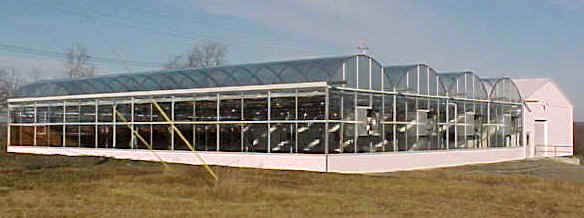| FLOATING
HYDROPONICS GREENHOUSE
|

A hydroponic lettuce demonstration greenhouse operation More pictures Address:
Currently operated by Challenge Industries, Inc., Ithaca NY. Please visit the web site of the lettuce greenhouse at http://www.fingerlakesfresh.com.
Cornell University's Controlled Environment Agriculture (CEA) Program has been involved in greenhouse hydroponic vegetable production research since 1991. Since early on, the goal was to develop systems to produce fresh, high-quality, pesticide-free vegetables close to market. Year-round and rapid production is made possible with accurate greenhouse climate control, including the integration of supplemental lighting and carbon dioxide enrichment of the greenhouse air. Especially during the darker winter months, supplemental lighting is needed to sustain sufficiently rapid plant growth required for profitable production. To integrate and demonstrate seven years of research results, it was decided to build a demonstration greenhouse based on a floating hydroponic (butterhead) lettuce production system used in the research. An agricultural cooperative (Agway, Inc.) partnered with Cornell University for the construction and operation of this demonstration greenhouse. Construction was started in March, 1998, and completed in April, 1999. Two full-time and one part-time greenhouse grower operate the facility and produce 945 heads of lettuce each day, seven days per week. It takes 36 days from seed to produce a target minimum fresh shoot mass of 150 g (5.3 ounces). Following construction, the facility has been in operation and the production has been closely monitored. Cornell University owns the rights to the developed production system. Future licensees would receive proper training in the demonstration facility before starting on their own. It is projected that the demonstration greenhouse could be the beginning of a new and high-tech vegetable industry in New York State and beyond. This web site describes the history of the project, including the design and construction of the 750 m2 (8,064 ft2) greenhouse and 360 m2 (3,840 ft2) headhouse. Special attention is given to the environment control of the plant production areas, including a growth room equipped with a water-cooled high-pressure sodium lighting system. Funding for the research and construction of the hydroponic lettuce demonstration facility was provided by:
Background In the Northeastern United States, year-round and rapid production is only possible with accurate greenhouse climate control, including the integration of supplemental lighting and carbon dioxide enrichment of the greenhouse air. Especially during the darker winter months, supplemental lighting is needed to sustain sufficiently rapid plant growth required for profitable production. Such energy intensive greenhouse systems can consume a large part of their electricity (mainly to operate the supplemental lighting system) during off-peak hours without adding much of an additional load during the high-demand hours of the day. Year-round and consistent production with a high turnover rate was thought key for the success of these capital-intensive production systems. Focusing on the production of a single crop allowed the (owner-) operators of these production systems to develop a high degree of specialization and a keen eye for detail. Two hydroponic growing systems have been utilized during the research: the nutrient film technique (NFT) and floating hydroponics (FH). For lettuce production, the FH system has clear advantages over the NFT system: (1) cheaper to install, (2) easy crop movement through the greenhouse, (3) large buffer capacity for pH and nutrients in the nutrient solution volume, and (4) large nutrient solution volume in direct contact with the plant roots (resulting in much less catastrophic conditions in case of circulation pump failure). Therefore, the FH system was implemented in the commercial demonstration. Labor Two full-time and one part-time greenhouse grower are employed at the demonstration facility. Their workweeks are staggered so that the facility is staffed seven days a week. At the start of each day, 945 lettuce plants are harvested to make room in the production system for the subsequent respacing and transplanting procedures, followed by the seeding operation. Currently, some additional labor is required to perform all the tasks within an eight-hour workday. However, the goal is to operate the facility with only two full-time employees. Some of the more routine tasks will be studied for possible further mechanization and optimization. Future Plans Since June, 1999, the Cornell lettuce demonstration facility has been in production and the lettuce has been sold to local supermarkets and wholesalers. An economic and a marketing study have been conducted in support of the overall evaluation of the production system. One of the aspects of the economic analysis was to investigate the cost of construction and operation, not only in Ithaca, NY, but also at various other locations throughout the country taking the different climate conditions and their effects on hydroponic lettuce production into account. The marketing study was supported by a local supermarket chain and investigated important attributes such as price flexibility, consumer preferences, year-round and consistent availability, packaging, display and location in the store, and consumer education. Research activities are continuing to improve the production system as well as marketing. Pictures of the Floating
Hydroponics Greenhouse Design:
More Information
|
|
|